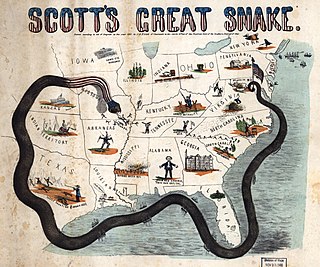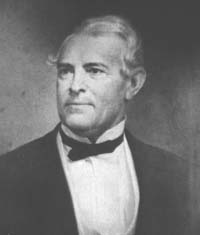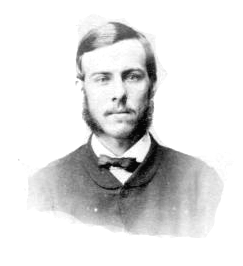
The Confederate States of America (CSA), commonly referred to as the Confederate States (C.S.), the Confederacy, or the South, was an unrecognized breakaway republic in the Southern United States that existed from February 8, 1861, to May 9, 1865. The Confederacy comprised eleven U.S. states that declared secession and warred against the United States during the American Civil War. The states are South Carolina, Mississippi, Florida, Alabama, Georgia, Louisiana, Texas, Virginia, Arkansas, Tennessee, and North Carolina.

The Confederate States Navy (CSN) was the naval branch of the Confederate States Armed Forces, established by an act of the Confederate States Congress on February 21, 1861. It was responsible for Confederate naval operations during the American Civil War against the United States's Union Navy.
Cotton diplomacy was the attempt by the Confederacy during the American Civil War to coerce Great Britain and France to support the Confederate war effort by implementing a cotton trade embargo against Britain and the rest of Europe. The Confederacy believed that both Britain and France, who before the war depended heavily on Southern cotton for textile manufacturing, would support the Confederate war effort if the cotton trade were restricted. Ultimately, cotton diplomacy did not work in favor of the Confederacy; as European nations largely sought alternative markets to obtain cotton. In fact, the cotton embargo transformed into a self-embargo which restricted the Confederate economy. Ultimately, the growth in the demand for cotton that fueled the antebellum economy did not continue.

The Union blockade in the American Civil War was a naval strategy by the United States to prevent the Confederacy from trading.
"King Cotton" is a slogan that summarized the strategy used before the American Civil War by secessionists in the southern states to claim the feasibility of secession and to prove there was no need to fear a war with the northern states. The theory held that control over cotton exports would make a proposed independent Confederacy economically prosperous, would ruin the textile industry of New England, and—most importantly—would force the United Kingdom and perhaps France to support the Confederacy militarily because their industrial economies depended on Southern cotton.

Kerr's Patent Revolver was an unusual 5-shot single-action revolver manufactured from 1859 to 1866 by the London Armoury Company. It was used by Confederate cavalrymen during the U.S. Civil War. Seven of these revolvers were held by the New Zealand Colonial Defence Force in 1863 and were issued to the famous Forest Rangers at the start of the campaign to push Māori rebels out of the Auckland province. It is easily recognized by its side-mounted hammer.

The London Armoury Company was a London arms manufactory that existed from 1856 until 1866. It was the major arms supplier to the Confederacy during the U.S. Civil War. The same company name was used during World War I to import arms from America such as the Colt New Service Revolver in 455 Eley.
The Confederate States of America (1861–1865) started with an agrarian-based economy that relied heavily on slave-worked plantations for the production of cotton for export to Europe and to the northern US. If classed as an independent country, the area of the Confederate States would have ranked as the fourth-richest country of the world in 1860. But, when the Union began its blockade of Confederate ports in the summer of 1861, exports of cotton fell 95% and the South had to restructure itself to emphasize the production of food and munitions for internal use. After losing control of its main rivers and ports, the Confederacy had to depend for transport on a delicate railroad system that, with few repairs being made, no new equipment, and destructive raids, crumbled away. The financial infrastructure collapsed during the war as inflation destroyed banks and forced a move toward a barter economy for civilians. The Confederate government seized needed supplies and livestock. By 1865, the Confederate economy was in ruins.

George Alfred Trenholm was a South Carolina businessman, financier, politician, and slaveholding planter who owned several plantations and strongly supported the Confederate States of America. He was appointed as its Secretary of the Treasury during the final year of the American Civil War.

James Dunwoody Bulloch was the Confederacy's chief foreign agent in Great Britain during the American Civil War. Based in Liverpool, he operated blockade runners and commerce raiders that provided the Confederacy with its only source of hard currency. Bulloch arranged for the purchase by British merchants of Confederate cotton, as well as the dispatch of armaments and other war supplies to the South. He also oversaw the construction and purchase of several ships designed at ruining Northern shipping during the Civil War, including CSS Florida, CSS Alabama, CSS Stonewall, and CSS Shenandoah. Due to him being a Confederate secret agent, Bulloch was not included in the general amnesty that came after the Civil War and therefore decided to stay in Liverpool, becoming the director of the Liverpool Nautical College and the Orphan Boys Asylum.
The Confederate Secret Service refers to any of a number of official and semi-official secret service organizations and operations conducted by the Confederate States of America during the American Civil War. Some of the organizations were under the direction of the Confederate government, others operated independently with government approval, while still others were either completely independent of the government or operated with only its tacit acknowledgment.

Josiah Gorgas was one of the few Northern-born Confederate generals and was later president of the University of Alabama.
Military leadership in the American Civil War was vested in both the political and the military structures of the belligerent powers. The overall military leadership of the United States during the Civil War was ultimately vested in the President of the United States as constitutional commander-in-chief, and in the political heads of the military departments he appointed. Most of the major Union wartime commanders had, however, previous regular army experience. A smaller number of military leaders originated from the United States Volunteers. Some of them derived from nations other than the United States.

Irvine Stephens Bulloch was an officer in the Confederate Navy and the youngest officer on the famed warship CSS Alabama. He fired its last shot before it was sunk off the coast of France at the end of the American Civil War. He was a half-brother of James Dunwoody Bulloch, who served as a foreign agent in Great Britain on behalf of the Confederacy, in part to arrange blockade runners.
The United Kingdom of Great Britain and Ireland remained officially neutral throughout the American Civil War (1861–1865). It legally recognized the belligerent status of the Confederate States of America (CSA) but never recognized it as a nation and neither signed a treaty with it nor ever exchanged ambassadors. Over 90 percent of Confederate trade with Britain ended, causing a severe shortage of cotton by 1862. Private British blockade runners sent munitions and luxuries to Confederate ports in return for cotton and tobacco. In Manchester, the massive reduction of available American cotton caused an economic disaster referred to as the Lancashire Cotton Famine. Despite the high unemployment, some Manchester cotton workers refused out of principle to process any cotton from America, leading to direct praise from President Lincoln, whose statue in Manchester bears a plaque which quotes his appreciation for the textile workers in "helping abolish slavery". Top British officials debated offering to mediate in the first 18 months, which the Confederacy wanted but the United States strongly rejected.

Caleb Huse was a major in the Confederate States Army, acting primarily as an arms procurement agent and purchasing specialist during the American Civil War. He is most well known for his successful acquisition of weapons contracts with various European nations including the United Kingdom, Austria, and to a lesser extent, France, Prussia, and Bohemia. A majority of the weapons imported to the Confederacy from foreign powers during the war were negotiated for and purchased by Huse.

During the American Civil War, blockade runners were used to get supplies through the Union blockade of the Confederate States of America that extended some 3,500 miles (5,600 km) along the Atlantic and Gulf of Mexico coastlines and the lower Mississippi River. The Confederacy had little industrial capability and could not indigenously produce the quantity of arms and other supplies needed to fight against the Union. To meet this need, numerous blockade runners were constructed in the British Isles and were used to import the guns, ordnance and other supplies that the Confederacy desperately needed, in exchange for cotton that the British textile industry needed greatly. To penetrate the blockade, these relatively lightweight shallow draft ships, mostly built in British shipyards and specially designed for speed, but not suited for transporting large quantities of cotton, had to cruise undetected, usually at night, through the Union blockade. The typical blockade runners were privately owned vessels often operating with a letter of marque issued by the Confederate government. If spotted, the blockade runners would attempt to outmaneuver or simply outrun any Union Navy warships on blockade patrol, often successfully.
The diplomacy of the American Civil War involved the relations of the United States and the Confederate States of America with the major world powers during the American Civil War of 1861–1865. The United States prevented other powers from recognizing the Confederacy, which counted heavily on Britain and France to enter the war on its side to maintain their supply of cotton and to weaken a growing opponent. Every nation was officially neutral throughout the war, and none formally recognized the Confederacy.

Charles Kuhn Prioleau (1827–1887) was an American cotton merchant who became the senior partner of Fraser, Trenholm & Company in Liverpool, England, a firm that functioned as the European banker of the Confederacy and was its major supplier for arms and military ware during the American Civil War. As a firm that frequently acted as the European banker of the Confederacy it often extended it credit, and was sometimes referred to as "the Confederate Embassy in England".
Sinclair, Hamilton & Company was a major arms dealer in Britain, and one of the two principle arms suppliers of the Confederacy during the American Civil War. The firm was established by Archibald Hamilton and his brother Robert in 1854 as a family business. During the war the firm often worked in conjunction with S. Isaac, Campbell & Company, the other primary supplier to the Confederate war effort. Both of these firms worked with Confederacy purchasing agents, Majors Caleb Huse and James Bulloch, sent to Britain by Josiah Gorgas, chief of the Confederate States War Department, to acquire badly needed arms for the Confederacy. These firms acted as commissioned purchasing and financial agents, middlemen, with the various arms manufacturers in England.